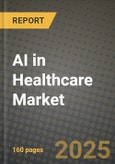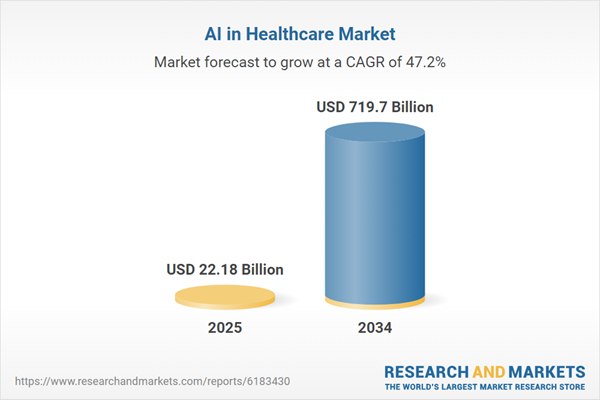AI in Healthcare Market
Artificial intelligence (AI) is reshaping healthcare across the care continuum - from prevention and triage to diagnosis, therapy selection, operational optimization, and post-acute monitoring. The most active applications include medical imaging interpretation, clinical decision support for differential diagnosis and risk stratification, ambient clinical documentation, virtual nursing, hospital operations (bed/OR throughput, staffing), revenue cycle integrity, patient engagement/chatbots, precision medicine (genomics, companion diagnostics), and drug discovery/clinical development. The latest wave centers on multimodal and foundation models that fuse text, images, signals, and omics; edge AI for point-of-care devices; privacy-preserving learning; and clinically tuned copilots embedded inside EHR and workflow tools. Demand is propelled by clinician shortages, rising chronic disease burden, value-based care incentives, payer scrutiny on quality and fraud, and the explosion of digitized data from EHRs, imaging, wearables, and real-world evidence. The competitive landscape spans hyperscale cloud providers, EHR and PACS vendors, med-tech and diagnostics companies, vertical AI specialists, CROs, and digital health startups, with pharma and providers forming data/validation partnerships. Procurement decisions hinge on validated clinical utility, safety and bias controls, auditability, interoperability, and integration effort rather than pure model performance. Regulatory pathways for software as a medical device are maturing, with increasing expectations for post-market surveillance, change management, and transparency. Despite strong momentum, adoption is gated by data quality and access, ROI proof, integration costs, workforce readiness, and governance. Vendors that deliver measurable outcomes at the service-line level, embed into clinician workflows, and align with cybersecurity and compliance requirements are best positioned.AI in Healthcare Market Key Insights
- Clinical value is moving from point models to workflow copilots. Buyers favor solutions that capture context across notes, orders, imaging, and vitals to streamline documentation, suggest orders, and surface risks inside existing EHR/PACS clicks. Products that reduce cognitive load and time-to-decision at the bedside or reading room see faster adoption than standalone dashboards, because they eliminate toggling and reinforce standard-of-care pathways.
- Imaging remains a gateway, but economics are shifting to platform bundles. Radiology and cardiology AI are proven entry points; however, hospitals increasingly purchase via marketplaces or enterprise licenses that bundle multiple use-cases. Success correlates with seamless study routing, unified QA/monitoring, and consolidated reporting. Vendors that demonstrate reduced turnaround, improved triage, and fewer unnecessary follow-ups win renewals.
- Ambient documentation is a breakout category. Speech-and-LLM systems cut charting time and burnout while improving note quality and coding capture. Differentiators include specialty-specific templates, latency, redaction of PHI, and accurate attribution into the EHR. Health systems judge offerings on end-to-end deployment effort, clinician satisfaction, and measurable downstream revenue integrity.
- Operational AI is a hidden ROI engine. Bed management, OR block optimization, discharge prediction, and denials prevention often deliver near-term savings. Leaders combine predictive models with prescriptive actions and closed-loop automation (e.g., smart paging, tasking). Integration into command centers and revenue cycle workflows is critical to capture value rather than producing “reporting exhaust.”
- Precision medicine expands beyond genomics. Multimodal models link pathology, radiology, and molecular data to inform theranostics and companion diagnostics. Hospitals prefer solutions that interoperate with LIS/PACS, manage versioned algorithms, and provide explainability for tumor boards. Partnerships with pharma and diagnostic assay vendors accelerate validation and reimbursement pathways.
- Trust, safety, and governance are decisive. Buyers require bias testing across demographic subgroups, data lineage, model cards, and guardrails for generative outputs. Contracts increasingly include human-in-the-loop assurances, audit trails, and rollback plans. Vendors offering continuous performance monitoring and real-world evidence registries shorten risk reviews and speed approvals.
- Data strategy beats model prowess. Access to high-quality, labeled, and diverse datasets - plus consent management, de-identification, and federated learning - drives durable advantage. Health systems seek partners that can harmonize data (FHIR, DICOM, HL7), enrich with ontologies, and maintain secure collaboration spaces for co-development without data leakage.
- Interoperability and deployment flexibility determine scale. API-first products with native FHIR integration, SMART-on-FHIR apps, and zero-footprint viewers reduce IT lift. Edge-capable inference for devices and scanners lowers latency and cloud costs. Reference architectures aligned to major clouds, EHRs, and PACS vendors shorten pilots and enable enterprise rollouts.
- Procurement is outcomes-based. Pilots now require predefined KPIs such as reduced length of stay, fewer readmissions, improved HCC capture, or radiology turnaround time improvements. Commercial models are shifting toward shared-savings, per-click, or service-line subscriptions with SLAs tied to uptime, latency, and accuracy thresholds in defined cohorts.
- Workforce enablement is the adoption throttle. Change management, clinician training, AI literacy, and clear policies for responsibility and escalation drive sustained use. Organizations invest in clinical AI councils, model governance committees, and super-user networks. Vendors that include training curricula, playbooks, and specialty champions reduce resistance and accelerate scale.
AI in Healthcare Market Reginal Analysis
North America
Adoption is propelled by advanced EHR penetration, payer pressure on quality and cost, and a robust ecosystem of cloud, EHR, and med-tech partners. Health systems focus on ambient documentation, imaging triage, and revenue cycle AI with clear ROI. Provider-payer data collaborations and real-world evidence networks support continuous model tuning, while mature cybersecurity and privacy frameworks shape vendor selection and contracting.Europe
Strong emphasis on safety, transparency, and data minimization informs procurement, with hospital groups piloting foundation-model copilots under strict governance. National strategies and cross-border research infrastructures facilitate federated learning and privacy-preserving analytics. Imaging AI and clinical decision support gain traction via marketplace integrations with leading PACS/EHR vendors, and outcome-based reimbursement pilots are expanding across select markets.Asia-Pacific
Rapid digitalization, large patient volumes, and strong public-private investment spur growth. Leading markets prioritize imaging AI for screening, telehealth triage, and hospital operations, often leveraging cloud-first deployments. Domestic innovators partner with device manufacturers to embed AI at the edge in scanners and monitors. Regulatory pathways are evolving quickly, with sandboxes enabling fast iteration while maintaining patient safety.Middle East & Africa
Flagship smart-hospital projects and national transformation programs catalyze adoption, particularly in radiology, command-and-control centers, and virtual care. Many buyers prefer turnkey platforms with managed services to offset skills gaps. Regional cloud footprints and data residency considerations shape architecture choices, while partnerships with academic centers support clinician training and localization.South & Central America
Health systems emphasize solutions that improve access and efficiency - AI-assisted triage, telehealth chat, and operational optimization. Public-private collaborations and philanthropic initiatives support pilots in oncology and cardiology imaging. Integration with existing EHRs is variable, so vendors with lightweight deployment models and strong training/support see better scale. Local data curation and language adaptation are critical for clinical acceptance.AI in Healthcare Market Segmentation
By Type
- Hardware (Processor
- Memory
- Network)
- Software (AI Platform
- AI Solution)
- Services
By Technology
- Machine Learning
- Natural Language Processing
- Context-aware Computing
- Computer Vision
By Application
- Patient Data and Risk Analysis
- Precision Medicine
- Lifestyle Management and Monitoring
- In-Patient Care and Hospital Management
- Medical Imaging and Diagnostics
- Drug Discovery
- Others
By End-User
- Hospitals
- Healthcare Payers
- Pharmaceuticals
- Patients
- Others
Key Market players
Microsoft, Google (including DeepMind), Amazon Web Services (AWS), NVIDIA, IBM, Oracle (Cerner), Siemens Healthineers, GE HealthCare, Philips, Epic Systems, Nuance Communications, Tempus, Flatiron Health, Viz.ai, Aidoc, Qure.ai, PathAI, Paige, Exscientia, BenevolentAIAI in Healthcare Market Analytics
The report employs rigorous tools, including Porter’s Five Forces, value chain mapping, and scenario-based modelling, to assess supply-demand dynamics. Cross-sector influences from parent, derived, and substitute markets are evaluated to identify risks and opportunities. Trade and pricing analytics provide an up-to-date view of international flows, including leading exporters, importers, and regional price trends.Macroeconomic indicators, policy frameworks such as carbon pricing and energy security strategies, and evolving consumer behaviour are considered in forecasting scenarios. Recent deal flows, partnerships, and technology innovations are incorporated to assess their impact on future market performance.
AI in Healthcare Market Competitive Intelligence
The competitive landscape is mapped through proprietary frameworks, profiling leading companies with details on business models, product portfolios, financial performance, and strategic initiatives. Key developments such as mergers & acquisitions, technology collaborations, investment inflows, and regional expansions are analyzed for their competitive impact. The report also identifies emerging players and innovative startups contributing to market disruption.Regional insights highlight the most promising investment destinations, regulatory landscapes, and evolving partnerships across energy and industrial corridors.
Countries Covered
- North America - AI in Healthcare market data and outlook to 2034
- United States
- Canada
- Mexico
- Europe - AI in Healthcare market data and outlook to 2034
- Germany
- United Kingdom
- France
- Italy
- Spain
- BeNeLux
- Russia
- Sweden
- Asia-Pacific - AI in Healthcare market data and outlook to 2034
- China
- Japan
- India
- South Korea
- Australia
- Indonesia
- Malaysia
- Vietnam
- Middle East and Africa - AI in Healthcare market data and outlook to 2034
- Saudi Arabia
- South Africa
- Iran
- UAE
- Egypt
- South and Central America - AI in Healthcare market data and outlook to 2034
- Brazil
- Argentina
- Chile
- Peru
Research Methodology
This study combines primary inputs from industry experts across the AI in Healthcare value chain with secondary data from associations, government publications, trade databases, and company disclosures. Proprietary modeling techniques, including data triangulation, statistical correlation, and scenario planning, are applied to deliver reliable market sizing and forecasting.Key Questions Addressed
- What is the current and forecast market size of the AI in Healthcare industry at global, regional, and country levels?
- Which types, applications, and technologies present the highest growth potential?
- How are supply chains adapting to geopolitical and economic shocks?
- What role do policy frameworks, trade flows, and sustainability targets play in shaping demand?
- Who are the leading players, and how are their strategies evolving in the face of global uncertainty?
- Which regional “hotspots” and customer segments will outpace the market, and what go-to-market and partnership models best support entry and expansion?
- Where are the most investable opportunities - across technology roadmaps, sustainability-linked innovation, and M&A - and what is the best segment to invest over the next 3-5 years?
Your Key Takeaways from the AI in Healthcare Market Report
- Global AI in Healthcare market size and growth projections (CAGR), 2024-2034
- Impact of Russia-Ukraine, Israel-Palestine, and Hamas conflicts on AI in Healthcare trade, costs, and supply chains
- AI in Healthcare market size, share, and outlook across 5 regions and 27 countries, 2023-2034
- AI in Healthcare market size, CAGR, and market share of key products, applications, and end-user verticals, 2023-2034
- Short- and long-term AI in Healthcare market trends, drivers, restraints, and opportunities
- Porter’s Five Forces analysis, technological developments, and AI in Healthcare supply chain analysis
- AI in Healthcare trade analysis, AI in Healthcare market price analysis, and AI in Healthcare supply/demand dynamics
- Profiles of 5 leading companies - overview, key strategies, financials, and products
- Latest AI in Healthcare market news and developments
Additional Support
With the purchase of this report, you will receive:- An updated PDF report and an MS Excel data workbook containing all market tables and figures for easy analysis.
- 7-day post-sale analyst support for clarifications and in-scope supplementary data, ensuring the deliverable aligns precisely with your requirements.
- Complimentary report update to incorporate the latest available data and the impact of recent market developments.
This product will be delivered within 1-3 business days.
Table of Contents
Companies Mentioned
- Microsoft
- Google (including DeepMind)
- Amazon Web Services (AWS)
- NVIDIA
- IBM
- Oracle (Cerner)
- Siemens Healthineers
- GE HealthCare
- Philips
- Epic Systems
- Nuance Communications
- Tempus
- Flatiron Health
- Viz.ai
- Aidoc
- Qure.ai
- PathAI
- Paige
- Exscientia
- BenevolentAI
Table Information
| Report Attribute | Details |
|---|---|
| No. of Pages | 160 |
| Published | November 2025 |
| Forecast Period | 2025 - 2034 |
| Estimated Market Value ( USD | $ 22.18 Billion |
| Forecasted Market Value ( USD | $ 719.7 Billion |
| Compound Annual Growth Rate | 47.2% |
| Regions Covered | Global |
| No. of Companies Mentioned | 20 |









